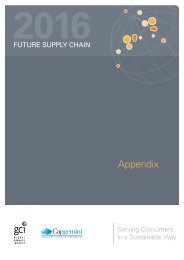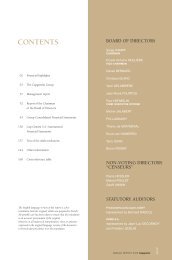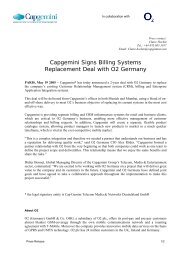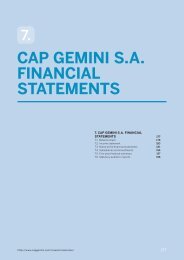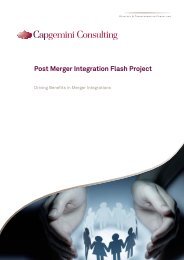Create successful ePaper yourself
Turn your PDF publications into a flip-book with our unique Google optimized e-Paper software.
VI – FINANCING POLICY AND MARKET<br />
RISKS<br />
Detailed information relating to (i) <strong>Capgemini</strong>’s cash and cash<br />
equivalents and debt; and (ii) the Group’s use of derivatives to<br />
manage its interest and currency risks is respectively provided in<br />
Notes 17 and 18 to <strong>Capgemini</strong>’s consolidated financial statements<br />
for the year ended December 31, 2006.<br />
6.1. Financing policy<br />
Cap Gemini’s financing policy is intended to provide the Group<br />
with adequate financial flexibility and is based on the following<br />
main criteria:<br />
A moderate use of debt leveraging: over the last ten years Cap<br />
Gemini has strived to maintain a limited level of net debt (and<br />
even a positive net cash position), including with respect to<br />
financing external growth. By paying for the bulk of its acquisitions<br />
in shares, Cap Gemini S.A. has pursued the dual aim of<br />
(i) maintaining a solid financial structure, and (ii) implicating<br />
as far as possible the employees transferred to the Group as a<br />
result of these acquisitions in their success.<br />
A high degree of financial flexibility: <strong>Capgemini</strong> aims to ensure<br />
a good level of liquidity as well as durable financial resources,<br />
which means maintaining:<br />
– a high level of available funds (€2,859 million at December<br />
31, 2006, including the proceeds from the €507 million capital<br />
increase carried out in December 2006), which could be<br />
expanded further by a €500 million undrawn multi-currency<br />
syndicated line of credit (expiring on November 14, 2011)<br />
and a €550 million commercial paper program;<br />
– durable financial resources: at December 31, 2006, 85% of the<br />
Group’s debt falls due beyond two years (see Note 17.III).<br />
Diversified financing sources adapted to the Group’s financial<br />
profile: <strong>Capgemini</strong> seeks to maintain a balance between bank<br />
financing (including the above-mentioned syndicated credit line,<br />
use of leasing to finance property and IT equipment in particular)<br />
and market financing (issue of OCEANE bonds convertible<br />
and/or exchangeable for new or existing shares for €460 million<br />
in June 2003 and €437 million in June 2005 (see Note 17.II).<br />
Lastly, the appropriate balance between the cash cost of financing<br />
and the return on cash investments, including the corresponding<br />
tax treatment, as well as the potential dilutive impact for Cap<br />
Gemini shareholders, are determining factors for the Group in<br />
its choice of financing sources. In this regard, with the issue of<br />
the OCEANE 2005 bonds Cap Gemini decided to neutralize the<br />
potential dilutive impact of the OCEANE bonds issued in June<br />
2003 via the purchase of call options on 9,019,607 of its own<br />
shares (see section 4.8 above).<br />
6.2. Market risks<br />
Equity risk: the Group does not hold any shares for financial<br />
investment purposes, and does not have significant interests<br />
in listed companies. However, it holds treasury shares in connection<br />
with:<br />
– the implementation of the liquidity contract under its share<br />
buyback program (the associated liquidity line amounts to €10<br />
million), representing 80,280 shares at December 31, 2006;<br />
– the employee-retention scheme set up in the context of the<br />
acquisition of Ernst & Young’s consulting business in May<br />
2000, under which the shares are designated to be reallocated<br />
to Group employees (see Note 10.A).<br />
The Group’s resulting exposure to equity risk is negligible.<br />
Counterparty risk: the financial assets which could potentially<br />
give rise to counterparty risk essentially consist of financial<br />
investments. These investments mainly comprise money market<br />
securities managed by leading financial institutions and, to a<br />
lesser degree, negotiable debt instruments issued by companies<br />
or financial institutions with a high credit rating from a recognized<br />
rating agency. There is therefore no significant counterparty<br />
risk for the Group on these short-term investments.<br />
Moreover, in line with its policy for managing currency and<br />
interest rate risks (see below), Cap Gemini enters into hedging<br />
agreements with leading financial institutions; counterparty risk<br />
can therefore be deemed negligible.<br />
Liquidity risk: the principal financial liabilities whose early<br />
repayment could expose the Group to liquidity risk are the<br />
two convertible bonds mentioned above (OCEANE 2003 and<br />
OCEANE 2005) and the €500 million multi-currency syndicated<br />
line of credit. The OCEANE documentation contains the<br />
usual provisions relating to early repayment at the initiative of<br />
bondholders should pre-defined events occur. In addition to<br />
the early repayment clauses commonly found in these types of<br />
agreements, the documentation for the syndicated line of credit<br />
requires Cap Gemini to comply with certain financial ratios<br />
(covenants). As of December 31, 2006, the Group complied<br />
with all such ratios (see Note 17.II.D).<br />
It is also stated that a change in the credit rating attributed by<br />
Standard & Poor’s to Cap Gemini would not affect the availability<br />
of these sources of financing and would therefore not<br />
expose the Group to liquidity risk. However, the cost of funding<br />
the syndicated line of credit could be increased or decreased<br />
(see Note 17.II.D).<br />
Interest rate risk: <strong>Capgemini</strong>’s exposure to interest rate risk<br />
should be analyzed in light of (i) its cash position: at December<br />
31, 2006 the Group had €2,859 million in cash and cash<br />
equivalents invested at market rates compared to gross debt of<br />
€1,224 million; and (ii) the Group’s conservative policy with<br />
respect to management of interest rate risk: the uncapped variable-rate<br />
portion of gross debt was limited to 6% (capped and<br />
uncapped variable-rate debt combined accounted for 41% of<br />
the total – see Note 17.III). Consequently, based on the balance<br />
sheet at end-2006 a 1% increase in interest rates would<br />
have a positive €20 million impact on <strong>Capgemini</strong>’s net finance<br />
costs. Conversely, a low interest rate environment (below 2%)<br />
would expose the Group to an increase in its net finance costs<br />
(see Note 17.III). The main exposure to interest rate risk is at<br />
the level of Cap Gemini S.A., which represented around 80% of<br />
Group financing and 66% of Group cash and cash equivalents<br />
at December 31, 2006.<br />
Currency risk: <strong>Capgemini</strong>’s exposure to currency risk is low<br />
due to the fact that the bulk of its revenue is generated in<br />
countries where operating expenses are also incurred. However,<br />
the growing use of offshore production centers in Poland, India<br />
and China exposes <strong>Capgemini</strong> to currency risk with respect to a<br />
portion of its production costs. Currently, the amounts involved<br />
are not material but given that this trend is set to increase in<br />
the future, Cap Gemini has already defined and implemented<br />
an overall policy to minimize exposure to exchange rates and<br />
ANNUAL REPORT 2006 <strong>Capgemini</strong><br />
47






